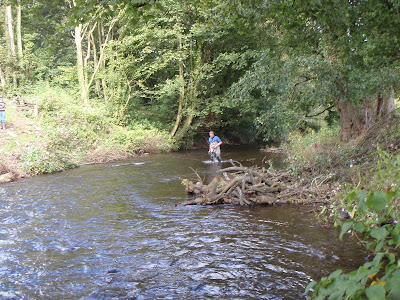Paul Stolk from Substance Coop sent these excellent photos
Friday, 1 October 2010
Monday, 27 September 2010
Sett/Goyt confluence. 22-Jan-2008
Sunday, 26 September 2010
... and a new, improved bank revetment
Two weeks back we hit a problem securing the brash in place; the existing masonry wall extends about a meter back from the river. Today thanks to Kurt we had a powerful masonry drill which made light work of fixing eyed Hilti bolts
As we were revisiting the job, Mike, Graeme, Stuart and Brian got to work making another half-dozen Xmas tree brash bundles
Finally these are secured top and bottom with fencing wire.
Here is our new, improved bank revetment. Another job well done boys.
Saturday, 25 September 2010
two more "V" flow deflectors ...
This morning Ross Lewis, Alan Marshall and I installed two more instream "V" flow deflectors at Strines. It took the three of us just 4 hours on a beautiful September day. A job well done boys.
Tomorrow more revetment work; watch this space ...
Wednesday, 22 September 2010
more Forestry brash
Today we cut more forestry brash to complete the bank revetment. DNMAC member Roger Lombard met me at the Forestry Commission site in the Goyt Valley; Maurice from Derbyshire County Council Countryside Service helped us to move it down to Mousley Bottom


Monday, 13 September 2010
After a couple of rainy days, the flow deflectors are doing their work
I've taken depth measurements downstream of each of the structures; will do comparison measurements in May 2011 to see the effect of the structures after one winter.
The scour can be clearly seen (the areas with the lighter stream-bed) in these pictures
The scour can be clearly seen (the areas with the lighter stream-bed) in these pictures
River Goyt Phase#2 improvements Sep-2010
March to June this year saw a series of teleconference and on-site meetings and submission of project designs/specifications from the Wild Trout Trust for another series of habitat improvement works to follow on from initial trial works done in 2008.
On Monday 06-Sep-2010, Tim Jacklin and Paul Gaskell from the Wild Trout Trust, Paul Breslin (E.A. biodiversity) and myself had meetings with four different landowners choosing suitable trees for introduction into the river to improve habitat for juvenile fish - as well as provide refuge from cormorant and goosander.
Wednesday saw first stage in practical works with tree felling for logs (walked downstream over riffles and pools into position for use on Saturday - sweaty work!). Tree "kickers" were also installed to complement/replace those put in two years ago.


On Monday 06-Sep-2010, Tim Jacklin and Paul Gaskell from the Wild Trout Trust, Paul Breslin (E.A. biodiversity) and myself had meetings with four different landowners choosing suitable trees for introduction into the river to improve habitat for juvenile fish - as well as provide refuge from cormorant and goosander.
Wednesday saw first stage in practical works with tree felling for logs (walked downstream over riffles and pools into position for use on Saturday - sweaty work!). Tree "kickers" were also installed to complement/replace those put in two years ago.
On Thursday, assisted by Andy Heath from Trent Rivers Trust, and Maurice and John from Derbyshire CC Countryside Service, we felled Christmas Tree brash at a Forestery Commission site in the Goyt Valley and ferried them to our site, along with the fixtures, fittings and equipment for log and brash revetment work for use on Saturday.
Friday saw Tim, Paul and myself joined by Kev Casey at Strines where we installed LWD structures to promote the formation of adult holding lies (scour holes) and mounds of spawning gravel (deposition of scoured material). We will have to wait for the next decent spates before the river completes our work for us though.
A good spot for a mini upstream "V" flow deflector. Each 2-m length of rebar needs whacking a couple of hundred times to break through the cobbles - but they get there in the end (ask Kev).

We introduced sit up logs on low "legs" to provide overhead cover for trout. These are fixed roughly in line with the current alongside feeding lanes where there is insufficient bankside or in-stream cover.

On the Saturday a dozen DNMAC members joined us to build a "soft engineered" bank revetment at Mousley Bottom where a stone wall was collapsing after being eroded by the force of the river. Instead of expensive and difficult "hard" engineering (which often "reflects" spate flows and promotes bank erosion downstream), a cheaper alternative which will also create habitat for juvenile fish and "brake" or damp out spate flows is the use of log and brash. A line of logs is pinned to the stream bed at the "toe" of the bank using rebar. Brash bundles are stuffed into the gaps behind the log and wired to the logs using fencing wire; stakes are driven through the brash bundles and nailed to the tops of the logs help to strengthen the structure.
Subscribe to:
Posts (Atom)



























